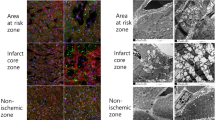Summary
Timely reperfusion with intravenous thrombolytic agents has been shown to reduce mortality in patients with acute myocardial infarction. However, the magnitude of improvement in left ventricular function has always been less than expected. Reperfusion in factcauses a specific form of tissue injury, termed reperfusion injury, which would substract from the benefit obtained by terminating ischemia. Oxygen free radical generation has been proposed to be a major mechanism in the pathogenesis of reperfusion injury. Using an isolated perfused rabbit heart model we have demonstrated that administration of oxygen free radical scavengers, such as recombinant human superoxide dismutase (h-SOD) and iron chelators, such as deferoxamine, beginning at the time of reperfusion, reduce the severity of reperfusion injury, as judged by recovery of ventricular function and high energy phosphate metabolism, assessed quantitatively using 31-phosphorus nuclear magnetic resonance spectroscopy. Using electron paramagnetic resonance spectroscopy we have documented a burst of oxygen free radical generation during the early minutes of reperfusion and that this burst can be eliminated by superoxide radical scavengers, such as h-SOD, hydroxyl radical scavengers, such as mannitol, as well as agents that inhibit generation of oxygen free radicals, such as the iron chelator, deferoxamine. Taken together these results strongly support the role of oxygen free radicals in the pathogenesis of reperfusion injury. We have recently completed the first randomized placebo controlled clinical trial of a free radical scavenger (h-SOD) in patients with acute myocardial infarction, undergoing urgent angioplasty of their occluded coronary artery with preservation of left ventricular function as the major study endpoint. While the results of this initial trial were largely negative, issues related to the dose and duration of therapy have been raised. Furthermore, new methods of assessment of regional left ventricular function were developed with improved sensitivity.
Similar content being viewed by others
References
Ambrosio G, Weisfeldt ML, Jacobus WE, Flaherty JT (1987) Evidence of a reversible oxygen radical mediated component of reperfusion injury: Reduction by recombinant human superoxide dismutase administered at the time of reflow. Circulation 75:282–291
Ambrosio G, Zweier JL, Jacobus WE, Weisfeldt ML, Flaherty JT (1987) Improvement of post-ischemic myocardial function and metabolism by administration of deferoxamine at the time of reflow: The role of iron in the pathogenesis of reperfusion injury. Circulation 76:906–915
Ambrosio G, Becker LC, Hutchins GM, Weisman HF, Weisfeldt ML (1986): Reduction in experimental infarct size by recombinant human superoxide dismutase: Insights into the pathophysiology of reperfusion injury. Circulation 74:1424–1433
Boveris A (1977) Mitochondrial production of superoxide radical and hydrogen peroxide. Adv Exp Med Biol 78:67–82
Eddy LJ, Stewart JR, Jones HP, Engleson TD, McCord JM, Downey JM (1987) Free radical producing enzymes, xanthine oxidase, is undetectable in human hearts. Am J Physiol 253 (H):709–711
Gallagher KP, Buda AJ, Pace D, Gerren RA, Shlafer M (1986) Failure of superoxide dismutase and catalase to alter size of infarction in conscious dogs after 3 h of occlusion followed by reperfusion. Circulation 73:1065–1076
Granger DN, Rutili G, McCord JM (1981) Superoxide radical in feline intestinal ischemia. Gastroenterology 81:22–29
Grill HP, Flaherty JT, Weisfeldt ML, Zweier JL (1988) Effect of superoxide dismutase on myocardial free radical concentrations during post-ischemic reperfusion. J Am Coll Card 11 (Suppl A):164 (Abstract)
Guerci AD, Gerstenblith G, Brinker JA, Gottlieb SO, Weiss JL, Chandra NC, Shapiro EC, Gottlieb SH, Ouyang P, Flaherty JT, Halperin HT, Mellits D, Bahr R, Siu C, Healy B, Becker LC (1988) A double-blind, placebo-controlled, randomized trial of tPA with subsequent randomization to elective PTGA for acute MI. N Engl J Med 37:1613–1618
Jarasche ED, Bruder G, Herd HW (1986) Significance of xanthine oxidase on capillary endothelial cells. A Physiol Scand Suppl 548:39–46
Jolly SR, Kane WJ, Bailie MB, Abrams GD, Lucchesi BR (1984) Canine myocardial reperfusion injury: Its reduction by the combined administration of superoxide dismutase and catalase. Circ Res 54:277–285
McCord JM (1987) Oxygen-derived radicals: a link between reperfusion injury and inflammation. Fed Proc 46:2402–2406
McCord JM (1985) Oxygen-derived free radicals in postischemic tissue injury. N Engl J Med 312:159–163
Nohl H, Breuninger V, Hegner D (1978) Influence of mitochondrial radical formation on energy linked respiration. Eur J Biochem 90:385–390
Turrens JF, Freeman BA, Crapo JD (1983) Enhancement of O2 and H2O2 production by lung mitochondria and microsomes during hyperoxia. In: Greenwald RA, Cohen G (eds) Oxy radicals and their scavenger systems Vol. II. Cellular and medical aspects. Elsevier, pp 365–370
Uraizee A, Reimer KA, Murry CE, Jennings RB (1987) Failure of superoxide dismutase to limit size of myocardial infarction after 40 min of ischemia and 4 days of reperfusion in dogs. Circulation 75:1237–1248
Werns SW, Shea MJ, Driscoll EM, Cohen C, Abrams GD, Pitt B, Lucchesi BR (1985) The independent effects of oxygen radical scavengers on canine infarct size: Reduction by superioxide dismutase but not catalase. Circ Res 56:895–898
Zweier JL, Flaherty JT, Weisfeldt ML (1987a) Direct measurement of free radical generation following reperfusion of ischemic myocardium. Proc Natl Acad Sci USA 84:1404–1407
Zweier JL, Rayburn BK, Flaherty JT, Weisfeldt ML (1987b) Recombinant superoxide dismutase reduces oxygen free radical concentrations in reperfused myocardium. J Clin Invest 80:1728–1734
Author information
Authors and Affiliations
Additional information
Manuscripts published in this issue were the matter of a Symposium held at the University of Ulm, April 24–27, 1991
Rights and permissions
About this article
Cite this article
Flaherty, J.T., Zweier, J.L. Role of oxygen radicals in myocardial reperfusion injury: Experimental and clinical evidence. Klin Wochenschr 69, 1061–1065 (1991). https://doi.org/10.1007/BF01645159
Issue Date:
DOI: https://doi.org/10.1007/BF01645159




